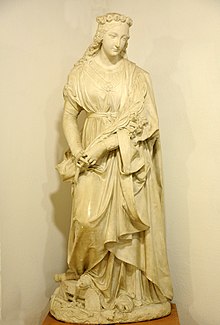Philomena of Rome

According to tradition, Philomena of Rome , also Filumena , Filomena or Creole Filomez (* 3rd century; † 302 in Rome ) was a Christian virgin who was beheaded in 302 during the persecution of Christians under Diocletian in Rome. St. Philomena is the patroness of children and infants, expectant mothers, the tortured and prisoners.
Life
According to the biography written by Pastor de Lucia, Philomena's father was a Greek king who had converted to Christianity . Emperor Diocletian wanted to marry Philomena, but rejected, as they are considered consecrated virgin the celibacy to Christ had vowed sake. The emperor had Philomena flagellated , shot at with arrows and thrown into the Tiber with an anchor around her neck , but she was always wonderfully saved. Eventually she was beheaded.
Adoration
Roman Catholic Church
On May 25, 1802, the grave of a young woman was found in the Priscilla Catacombs in Rome . The Latin inscription LUMENA | PAX TE | CUM FI was written on three tiles . The order of the plates was obviously reversed. Correctly arranged it says: PAX TECUM FILUMENA “Peace be upon you, Filumena”. The symbols on the tablets were interpreted as a palm branch , arrows, anchor and lily . A glass jar of ointment was found next to her head and its contents were thought to be blood remains. From this it was concluded that they must be relics of a martyr named Filumena or Philomena .
Pastor Francesco de Lucia (1772–1847) had the relics brought to Naples in June 1805 . After a long drought, rain and healing of the sick were attributed to Philomena as miracles. On August 10, 1805, the relics and , in 1827, the brick slabs found near the grave were brought to Mugnano del Cardinale in the diocese of Nola .
The nun Maria Luisa di Gesù and others claimed to have experienced the life of Philomenas through private revelations . This biography was embellished by Pastor de Lucia. The veneration spread rapidly in Italy and especially in France . Especially Pauline Marie Jaricot who had been healed on 10 August 1835 at the grave Philomenas from a serious illness, and the holy Cure of Ars , Jean-Marie Vianney , promoted the worship Philomenas.
At the same time, there were also voices in the 19th century who criticized this. The wrong order of the found plates could mean that the plates were originally placed on another grave. The martyrdom of Philomenas is in many ways similar to that of other virgin martyrs, such as Agatha of Catania or Lucia of Syracuse .
Because of the many miracles, Pope Gregory XVI allowed 1834 and introduced the memorial day of Philomenas in 1837 . Pope Pius IX , who attributed his healing from convulsions to the intercession of Philomenas, bestowed her on the honorary title "Protector of the Rosary ". In 1961, the Philomenas Day was deleted from the liturgical calendar of the Catholic Church . Her feast day in the earlier liturgical calendar is August 11th .
iconography
The saint is usually represented with her attributes , an anchor, a lily, three arrows and a scourge.
Communities named after the saint
- Poor Daughters of the Most Holy Virgin and Saint Philomena , founded in 1835 near Poitiers , France
- Arch brotherhood of St. Philomena , founded in Paris in 1884 as a prayer community
Haitian voodoo
In Haitian voodoo , Philomena is syncretistically worshiped by Rome in the form of the female loa Filomez . She is portrayed as a young trader dressed in bright colors and called upon to gain wealth . Sometimes she is portrayed as a woman who removes negative things with a broom. She is attributed to betraying secrets to people in dreams and almost never causing obsession . She is considered to be a water-connected, benevolent spirit from the Nachon Rada .
- → See also list of spirit beings in Voodoo
See also
Places named after the saint: Santa Filomena
literature
- Giovanni Braschi: Philomena. The saint from the catacombs . Schmid, Durach 1991
- Jean Darche et al: Once upon a time ...: the then and now of Philomena worship . Theresia, Seewen 1995, ISBN 3-908542-39-1
- Gerd-Klaus Kaltenbrunner: Beloved Philomena. Small love letter to a saint found again . Theresia, Lauerz 1995, ISBN 3-908542-49-9
- Georg Mautner Markhof: The uncomfortable miracle. Church dispute over Philomena 1802–1981 . Poseidon Press, Vienna 1981, DNB 994844298
- Th. Nelk: The holy Filomena, virgin and martyr, the miracle worker of the nineteenth century . Ruhland, Altötting approx. 1990
- Ekkart Sauser : Philomena. In: Biographisch-Bibliographisches Kirchenlexikon (BBKL). Volume 7, Bautz, Herzberg 1994, ISBN 3-88309-048-4 , Sp. 521-523.
- Hans Reinhard Seliger: Philomena of Rome . In Lexicon of Saints and Adoration of Saints . (IQ) Volume 2. Herder, Freiburg i. B. 2003, ISBN 3-451-28192-9
Individual evidence
- ↑ William Rizzuto: Origins of the Lwa ( Memento of the original from March 14, 2014 in the Internet Archive ) Info: The archive link was inserted automatically and has not yet been checked. Please check the original and archive link according to the instructions and then remove this notice. , Vodou Roots, 2013
- ↑ Boukman Eksperyans: Filomèz , hougansydney.com, undated
Web links
- Literature by and about Philomena of Rome in the catalog of the German National Library
- Philomena Center Germany
- Saint Philomena
- Sanctuary of St. Philomena (English and Italian)
- Philomena in the Ecumenical Lexicon of Saints
- Depiction of St. Philomena in the "Catholic Enzyclopedia" (Engl.)
| personal data | |
|---|---|
| SURNAME | Philomena of Rome |
| ALTERNATIVE NAMES | Filumena, Filomena |
| BRIEF DESCRIPTION | Christian virgin and martyr |
| DATE OF BIRTH | 3rd century |
| DATE OF DEATH | 302 |
| Place of death | Rome |